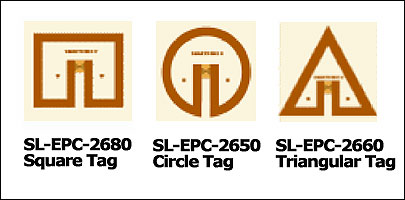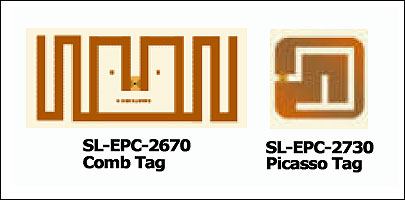RFID systems provider SmartCode has announced five new 860-950 MHz UHF EPC Gen 2 inlays specially designed for item-level tagging. These inlays can be used to identify pharmaceuticals and other individual products, or to recognize consumer items such as apparel or packaged goods.
“This expansion into item-level [tags] is a natural extension of our business, and we are happy to see the strong demand for item-level,” says Roy Apple, SmartCode’s senior vice president of business development.
|
|
One inlay, the Picasso, is intended for conversion into a 1.05-by-1.05-inch label for pill bottles. Three other inlays—the Square, the Triangle and the Circle—are built for use in item-level labels for consumer packaged goods and media, such as DVDs. A fifth design, the Comb, is the largest of the new inlays, designed for maximum readability regardless of the tag’s orientation to the reader or the contents of the product being identified.
The inlays contain antennas suitable for near-field interrogation. The near field is within one wavelength of the tag’s antenna. For signals transmitted at 860 to 928 MHz, one wavelength is approximately 33 centimeters (13 inches). Near-field tags, therefore, have a read range far shorter than that of conventional UHF tags, which use antennas optimized for far-field radio frequency operation—that is, for distances greater than one wavelength—and can offer a read range of 30 feet or more. The near-field tags’ shorter read range makes the inlays well suited for reading tags at the item level because in such applications, the interrogator’s antenna is generally brought close to the tag being read. Near-field UHF tags operate well near water (or even in it) because dielectrics (nonconductors) do not attenuate inductive (magnetic) near-field signals. When placed on metal, passive UHF RFID tags—whether designed for the near field or for the far field—can operate well if their antennas are designed to work with metal’s tendency to reflect the waves generated by the reader.
Apple says the SmartCode inlays have a 1- to 2-foot read range, though some tags have reportedly been readable at 3 feet in lab tests.
In order to read near-field UHF tags, users will need to install interrogator antennas operating in the near, or magnetic energy, field. Antennas for conventional UHF tags operate in the radio frequency energy field. However, any UHF interrogator that can read UHF EPC Gen 2 tags can support near-field antennas, so no other infrastructure changes are required.
According to Apple, the SmartCode near-field UHF inlays are currently working with some undisclosed end users to test the inlays in technology trials that involve tracking pharmaceuticals, jewelry, cosmetics and rental DVDs.
The inlays will be available in May at a cost of 8.5 cents each for quantities of 1 million or more units. The inlays must be converted into tags (adhesive smart labels or “naked” on-pitch tags) before being applied to goods. SmartCode is working with a number of chip suppliers to source the Gen 2 chips used in the inlays, and is currently using etched copper and aluminum antennas. Presently, the company is testing printable, silver-ink antennas, as well, the use of which could lower the price of the inlays—in high volumes, printed antennas are cheaper to produce than etched antennas.
Apple notes that SmartCode is developing inlays with both near- and far-field antennas, designed for use on goods that must be identified at both a short and long distance. He expects these tags, which he refers to as “multi-field,” to be available in the third quarter of 2006.
In February, tag maker Avery Dennison announced two new inlays in its Gen 2 portfolio that use near-field and near-field/far-field antenna designs: the AD-811 (AD-812 for Europe) and AD-820 (AD-821 for Europe). For more information, see Avery Dennison Unveils New Gen 2 Inlays.



